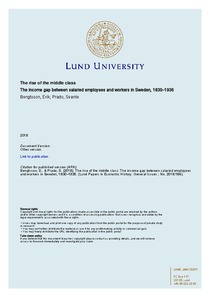The rise of the middle class: the income gap between salaried employees and workers in Sweden, 1830–1935

Bengtsson, Erik ; Prado, Svante
Lund University. Department of Economic History
Lund University - Lund
2018
28 p.
wages ; wage structure ; history ; middle class ; working class ; income distribution
Lund Papers in Economic History
186
Wages and wage payment systems
English
Bibliogr.
"We present the first comprehensive, long run salary information on Swedish middle-class employees before the twentieth century. Our data include school teachers, professors, clerks, policemen and janitors in Stockholm 1830–1935. We use the new data to compare the annual earnings of these middle-class employees with the annual earnings of farm workers and manufacturing workers. The results show that the income gap between the middle class and the working class widen drastically from the mid-nineteenth century to a historically high level during the 1880s and 1890s. The differentials then decreased during the first four decades of the twentieth century. The bulging earnings advantage of middle-class employees vis-à-vis unskilled workers chimes with Kocka's depiction of the latter half of the nineteenth century as the era of the bourgeoisie."
Digital
The ETUI is co-funded by the European Union. Views and opinions expressed are however those of the author(s) only and do not necessarily reflect those of the European Union or the ETUI.